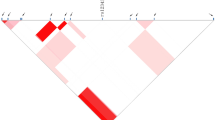Abstract
Background and purpose
Thrombomodulin is expressed at the surface of endothelial cells and controls thrombin generation and thrombin-induced platelets and vascular cell activation. Several thrombomodulin gene polymorphisms have been associated with coronary events and brain infarction. In a previous analysis from the Etude du Profil Génétique de l'Infarctus Cérébral (GENIC) study, we found that soluble thrombomodulin (sTM) concentration modulated the risk of and prognosis for brain infarction.
Methods
In 474 brain infarction cases and 483 controls from the GENIC study, we investigated the relationship between three thrombomodulin gene polymorphisms (–1748G/C, –1208/–1209delTT, +1418C/T) and sTM levels, brain infarction risk and 5-year mortality after stroke.
Results
The three polymorphisms were in linkage disequilibrium and defined three major haplotypes with no influence on sTM concentration (all P values > 0.16). Single locus and haplotype analyses found no significant association with brain infarction, even when the analysis was restricted to individuals without a vascular history. After 5 years of follow-up, we found no relationship with vascular or total mortality (all P values > 0.64).
Conclusion
Our results suggest that these three thrombomodulin gene polymorphisms do not contribute to sTM level variations and are not associated with risk of brain infarction and mortality after stroke.
Similar content being viewed by others
References
Esmon CT, Owen WG (1981) Identification of an endothelial cell cofactor for thrombin-catalyzed activation of protein C. Proc Natl Acad Sci USA 78:2249–2252
Esmon NL, Carroll RC, Esmon CT (1983) Thrombomodulin blocks the ability of thrombin to activate platelets. J Biol Chem 258:12238–12242
Olivot JM, Estebanell E, Lafay M, Brohard B, Aiach M, Rendu F (2001) Thrombomodulin prolongs thrombininduced extracellular signal-regulated kinase phosphorylation and nuclear retention in endothelial cells. Circ Res 88:681–687
Wen DZ, Dittman WA, Ye RD, Deaven LL, Majerus PW, Sadler JE (1987) Human thrombomodulin: complete cDNA sequence and chromosome localization of the gene. Biochemistry 26:4350–4357
Ireland H, Kunz G, Kyriakoulis K, Stubbs PJ, Lane DA (1997) Thrombomodulin gene mutations associated with myocardial infarction (see comments). Circulation 96:15–18
Esmon CT (1997) Defects in natural anticoagulant pathways as potential risk factors for myocardial infarction. Circulation 96:9–11
Wu KK, Aleksic N, Ahn C, Boerwinkle E, Folsom AR, Juneja H (2001) Thrombomodulin Ala455Val polymorphism and risk of coronary heart disease. Circulation 103:1386–1389
Cole JW, Roberts SC, Gallagher M, Giles WH, Mitchell BD, Steinberg KK, Wozniak MA, Macko RF, Reinhart LJ, Kittner SJ (2004) Thrombomodulin Ala455Val polymorphism and the risk of cerebral infarction in a biracial population: the Stroke Prevention in Young Women Study. BMC Neurol 4:21
Le Flem L, Mennen L, Aubry ML, Aiach M, Scarabin PY, Emmerich J, Alhenc- Gelas M (2001) Thrombomodulin promoter mutations, venous thrombosis, and varicose veins. Arterioscler Thromb Vasc Biol 21:445–451
Auro K, Komulainen K, Alanne M, Silander K, Peltonen L, Perola M, Salomaa V (2006) Thrombomodulin gene polymorphisms and haplotypes and the risk of cardiovascular events. A prospective follow-up study. Arterioscler Thromb Vasc Biol 26:942–947
Olivot JM, Labreuche J, Aiach M, Amarenco P (2004) Soluble thrombomodulin and brain infarction: casecontrol and prospective study. Stroke 35:1946–1951
Tanne D, Macko RF, Lin Y, Tilley BC, Levine SR (2006) Hemostatic activation and outcome after recombinant tissue plasminogen activator therapy for acute ischemic stroke. Stroke 37:1798–1804
Touboul PJ, Elbaz A, Koller C, Lucas C, Adrai V, Chedru F, Amarenco P (2000) Common carotid artery intima-media thickness and brain infarction: the Etude du Profil Génétique de l’Infarctus Cerebral (GENIC) case-control study. The GENIC Investigators. Circulation 102:313–318
Tregouet DA, Escolano S, Tiret L, Mallet A, Golmard JL (2004) A new algorithm for haplotype-based association analysis: the Stochastic-EM algorithm. Ann Hum Genet 68:165–177
Tregouet DA, Tiret L (2004) Cox proportional hazards survival regression in haplotype-based association analysis using the Stochastic-EM algorithm. Eur J Hum Genet 12:971–974
Tiret L, Amouyel P, Rakotovao R, Cambien F, Ducimetiere P (1991) Testing for association between disease and linked marker loci: a loglinear- model analysis. Am J Hum Genet 48:926–934
Konstantoulas CJ, Cooper J, Warnock G, Miller GJ, Humphries SE, Ireland H (2004) A combination of two common thrombomodulin gene variants (–1208–1209TTdelTT and A455V) influence risk of coronary heart disease: a prospective study in men. Atherosclerosis 177:97–104
Kunz G, Ireland HA, Stubbs PJ, Kahan M, Coulton GC, Lane DA (2000) Identification and characterization of a thrombomodulin gene mutation coding for an elongated protein with reduced expression in a kindred with myocardial infarction. Blood 95:569–576
Kunz G, Ohlin AK, Adami A, Zoller B, Svensson P, Lane DA (2002) Naturally occurring mutations in the thrombomodulin gene leading to impaired expression and function. Blood 99:3646–3653
Aleksic N, Folsom AR, Cushman M, Heckbert SR, Tsai MY, Wu KK (2003) Prospective study of the A455V polymorphism in the thrombomodulin gene, plasma thrombomodulin, and incidence of venous thromboembolism: the LITE Study. J Thromb Haemost 1:88–94
Le Flem L, Picard V, Emmerich J, Gandrille S, Fiessinger JN, Aiach M, Alhenc-Gelas M (1999) Mutations in promoter region of thrombomodulin and venous thromboembolic disease. Arterioscler Thromb Vasc Biol 19:1098–1104
Reny JL, Remones V, Fontana P, Bieche I, Desvard F, Aubry ML, Gaussen P, Aiach M (2005) The thrombomodulin- 1208/–1209delTT gene promoter polymorphism does not affect basal or LPS-dependent monocyte TM mRNA transcription in healthy volunteers. Thromb Haemost 94:686–687
Lohi O, Urban S, Freeman M (2004) Diverse substrate recognition mechanisms for rhomboids; thrombomodulin is cleaved by Mammalian rhomboids. Curr Biol 14:236–241
Author information
Authors and Affiliations
Consortia
Corresponding author
Additional information
*A list of the GENIC Investigators is available at http://genic.medecine.univ-paris7.fr.
Rights and permissions
About this article
Cite this article
Olivot, JM., Labreuche, J., De Broucker, T. et al. Thrombomodulin gene polymorphisms in brain infarction and mortality after stroke. J Neurol 255, 514–519 (2008). https://doi.org/10.1007/s00415-008-0725-x
Received:
Revised:
Accepted:
Published:
Issue Date:
DOI: https://doi.org/10.1007/s00415-008-0725-x




